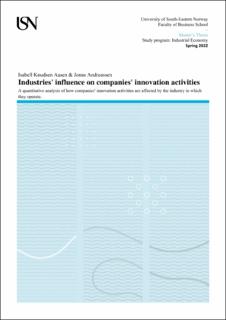| dc.contributor.advisor | Zabala-Iturriagagoitia, Jon Mikel | |
| dc.contributor.author | Aasen, Isabell Knudsen | |
| dc.contributor.author | Andreassen, Jonas | |
| dc.date.accessioned | 2022-08-11T16:43:13Z | |
| dc.date.available | 2022-08-11T16:43:13Z | |
| dc.date.issued | 2022 | |
| dc.identifier | no.usn:wiseflow:6590499:50569291 | |
| dc.identifier.uri | https://hdl.handle.net/11250/3011442 | |
| dc.description.abstract | På grunn av det stadig mer konkurransepregede markedet dagens samfunn opplever, må bedrifter investere store mengder ressurser i innovasjonsaktiviteter (Pring-Mill, 2019; Damanpour & Wischenvsky, 2006). Det er imidlertid betydelige forskjeller mellom bedrifters innovasjonsaktiviteter på tvers av ulike bransjer. Ved å se nærmere på denne problemstillingen, ble det oppdaget to motstridende teorier om hvordan bedrifters innovasjonsaktiviteter påvirkes av bransjen de opererer i. Disse to teoriene er the evolutionary theory og technological regimes theory.
The evolutionary theory dreier seg i hovedsak om argumentet om at innovasjonsmønstre ikke er knyttet til bransjer, men til bedrifter (Hollenstein, 2019). Innovasjonsmønstrene er formet av bedriftens unike ressurser, dynamiske evner og rutiner. Dette resulterer i ulike læringsaktiviteter og tilnærminger til innovasjon, og skaper dermed bedrift heterogenitet (Prahalad, 1993). På den andre siden, i henhold til technological regimes theory, blir innovasjonsmønstre sett på som gjeldende for bransjer og ikke for bedrifter. Derfor følger bedrifter innenfor samme bransje et homogent innovasjonsmønster på grunn av bransjens teknologiske regime (Leiponen & Drejer, 2007).
Derfor hadde denne masteroppgaven som mål å svare på forskningsspørsmålet: "Hvordan påvirkes en bedrifts innovasjonsaktiviteter av bransjen den opererer i?" Sammen med forskningsspørsmålet ble det også laget to hypoteser: "Bedrifters innovasjonsaktiviteter påvirkes kun av bransjens teknologiske regime" og "Evolutionary theory og technological regime theory er ikke komplementære." Disse ble undersøkt gjennom analyser av en kvantitativ undersøkelse utført av 71 bedrifter fra fire ulike bransjer.
Det ble konkludert med at de to motstridende teoriene begge er gyldige. Implikasjonen dette innebærer er at graden bransjer påvirker bedrifters innovasjonsaktiviteter vil variere på tvers av bransjer. Resultatet av dette er at ingen bransjers innovasjonsaktiviteter er helt heterogene, men heller ikke helt homogene. De to teoriene er derfor komplementære, siden de begge forklarer ulike sider ved bedrifters innovasjonsaktiviteter og dermed utfyller hverandre. | |
| dc.description.abstract | Due to the increasingly competitive market today’s society is experiencing, companies must invest large amounts of resources in innovation activities (Pring- Mill, 2019; Damanpour & Wischenvsky, 2006). However, there are significant differences between companies’ innovation activities across different industries. When looking into this issue, two conflicting theories were discovered regarding how companies' innovation activities are affected by the industry in which they operate. These two theories are the recent evolutionary theory and technological regimes theory.
The recent evolutionary theory essentially revolves around the argument that innovation patterns are not linked to industries, but to companies (Hollenstein, 2019). The innovation patterns are shaped by the company's unique resources, dynamic capabilities and routines which results in different learning activities and approaches to innovation, creating firm heterogeneity (Prahalad, 1993). On the other hand, according to technological regimes theory, innovation patterns are viewed as applicable to the industry and not to companies. Therefore, companies within the same industry follow a homogenous innovation pattern due to the industry’s technological regime (Leiponen & Drejer, 2007).
Therefore, this master’s thesis aimed to answer the research question: "How are a company's innovation activities affected by the industry in which it operates?". Together with the research question, two hypotheses were also created: “Companies ́ innovation activities are only influenced by the industry’s technological regime” and “Evolutionary theory and technological regime theory are not complementary.” These were examined through analyses of a quantitative survey conducted by 71 firms from four different industries.
It was concluded that the two contradictory theories, technological regime and evolutionary theory, both are valid. The implication this entails is that the degree industries affect firms’ innovation activities, will vary across industries. The result of this is that no industry’s innovation activities are completely heterogeneous, but neither are they exactly homogeneous. The two theories are therefore complementary, since they both explain different aspects of companies’ innovation activities and thus fulfilling each other. | |
| dc.language | eng | |
| dc.publisher | University of South-Eastern Norway | |
| dc.title | Bransjers påvirkningskraft på bedrifters innovasjon aktiviteter | |
| dc.type | Master thesis | |

